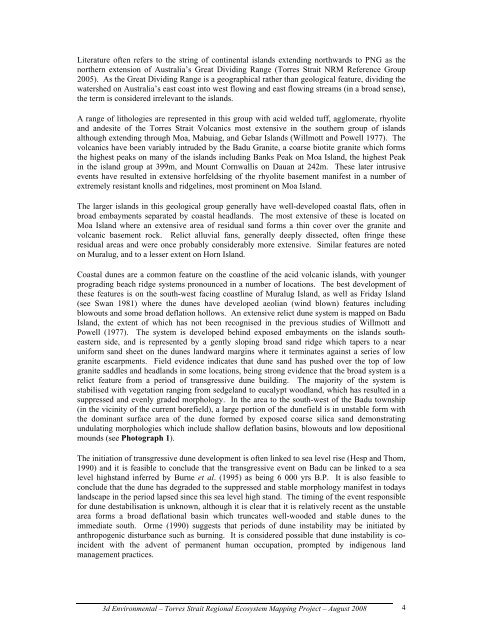Appendix 2 - Vegetation Communities and Regional Ecosystems
Appendix 2 - Vegetation Communities and Regional Ecosystems
Appendix 2 - Vegetation Communities and Regional Ecosystems
Create successful ePaper yourself
Turn your PDF publications into a flip-book with our unique Google optimized e-Paper software.
Literature often refers to the string of continental isl<strong>and</strong>s extending northwards to PNG as the<br />
northern extension of Australia’s Great Dividing Range (Torres Strait NRM Reference Group<br />
2005). As the Great Dividing Range is a geographical rather than geological feature, dividing the<br />
watershed on Australia’s east coast into west flowing <strong>and</strong> east flowing streams (in a broad sense),<br />
the term is considered irrelevant to the isl<strong>and</strong>s.<br />
A range of lithologies are represented in this group with acid welded tuff, agglomerate, rhyolite<br />
<strong>and</strong> <strong>and</strong>esite of the Torres Strait Volcanics most extensive in the southern group of isl<strong>and</strong>s<br />
although extending through Moa, Mabuiag, <strong>and</strong> Gebar Isl<strong>and</strong>s (Willmott <strong>and</strong> Powell 1977). The<br />
volcanics have been variably intruded by the Badu Granite, a coarse biotite granite which forms<br />
the highest peaks on many of the isl<strong>and</strong>s including Banks Peak on Moa Isl<strong>and</strong>, the highest Peak<br />
in the isl<strong>and</strong> group at 399m, <strong>and</strong> Mount Cornwallis on Dauan at 242m. These later intrusive<br />
events have resulted in extensive horfeldsing of the rhyolite basement manifest in a number of<br />
extremely resistant knolls <strong>and</strong> ridgelines, most prominent on Moa Isl<strong>and</strong>.<br />
The larger isl<strong>and</strong>s in this geological group generally have well-developed coastal flats, often in<br />
broad embayments separated by coastal headl<strong>and</strong>s. The most extensive of these is located on<br />
Moa Isl<strong>and</strong> where an extensive area of residual s<strong>and</strong> forms a thin cover over the granite <strong>and</strong><br />
volcanic basement rock. Relict alluvial fans, generally deeply dissected, often fringe these<br />
residual areas <strong>and</strong> were once probably considerably more extensive. Similar features are noted<br />
on Muralug, <strong>and</strong> to a lesser extent on Horn Isl<strong>and</strong>.<br />
Coastal dunes are a common feature on the coastline of the acid volcanic isl<strong>and</strong>s, with younger<br />
prograding beach ridge systems pronounced in a number of locations. The best development of<br />
these features is on the south-west facing coastline of Muralug Isl<strong>and</strong>, as well as Friday Isl<strong>and</strong><br />
(see Swan 1981) where the dunes have developed aeolian (wind blown) features including<br />
blowouts <strong>and</strong> some broad deflation hollows. An extensive relict dune system is mapped on Badu<br />
Isl<strong>and</strong>, the extent of which has not been recognised in the previous studies of Willmott <strong>and</strong><br />
Powell (1977). The system is developed behind exposed embayments on the isl<strong>and</strong>s southeastern<br />
side, <strong>and</strong> is represented by a gently sloping broad s<strong>and</strong> ridge which tapers to a near<br />
uniform s<strong>and</strong> sheet on the dunes l<strong>and</strong>ward margins where it terminates against a series of low<br />
granite escarpments. Field evidence indicates that dune s<strong>and</strong> has pushed over the top of low<br />
granite saddles <strong>and</strong> headl<strong>and</strong>s in some locations, being strong evidence that the broad system is a<br />
relict feature from a period of transgressive dune building. The majority of the system is<br />
stabilised with vegetation ranging from sedgel<strong>and</strong> to eucalypt woodl<strong>and</strong>, which has resulted in a<br />
suppressed <strong>and</strong> evenly graded morphology. In the area to the south-west of the Badu township<br />
(in the vicinity of the current borefield), a large portion of the dunefield is in unstable form with<br />
the dominant surface area of the dune formed by exposed coarse silica s<strong>and</strong> demonstrating<br />
undulating morphologies which include shallow deflation basins, blowouts <strong>and</strong> low depositional<br />
mounds (see Photograph 1).<br />
The initiation of transgressive dune development is often linked to sea level rise (Hesp <strong>and</strong> Thom,<br />
1990) <strong>and</strong> it is feasible to conclude that the transgressive event on Badu can be linked to a sea<br />
level highst<strong>and</strong> inferred by Burne et al. (1995) as being 6 000 yrs B.P. It is also feasible to<br />
conclude that the dune has degraded to the suppressed <strong>and</strong> stable morphology manifest in todays<br />
l<strong>and</strong>scape in the period lapsed since this sea level high st<strong>and</strong>. The timing of the event responsible<br />
for dune destabilisation is unknown, although it is clear that it is relatively recent as the unstable<br />
area forms a broad deflational basin which truncates well-wooded <strong>and</strong> stable dunes to the<br />
immediate south. Orme (1990) suggests that periods of dune instability may be initiated by<br />
anthropogenic disturbance such as burning. It is considered possible that dune instability is coincident<br />
with the advent of permanent human occupation, prompted by indigenous l<strong>and</strong><br />
management practices.<br />
3d Environmental – Torres Strait <strong>Regional</strong> Ecosystem Mapping Project – August 2008<br />
4


